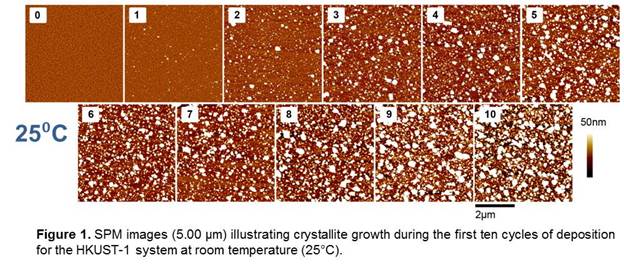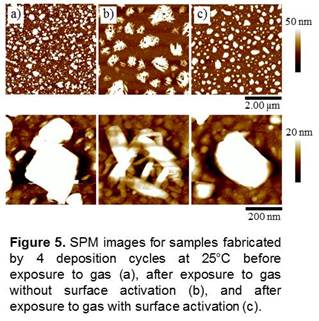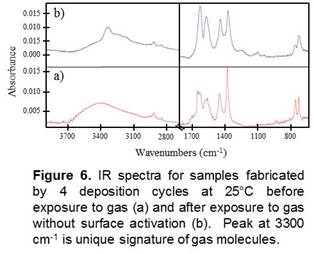Reports: UNI554106-UNI5: Assembly and Characterization of Metal-Organic Coordinated Thin Films with Designed Catalytic Sites
Mary Elizabeth Anderson, PhD, Hope College
Thin films can integrate the versatility and great potential found in the emerging field of metal-organic frameworks directly into architectures for catalysis, gas storage, and gas separations. Metal-organic frameworks (MOFs) are crystalline, porous materials exhibiting great potential for petrochemical processing, with structures comparable to zeolites. By selecting a specific combination of organic ligands and coordinating metal ions, MOFs can be tailored by tuning pore size, shape, and composition. This diversity of physical and chemical properties has generated anticipation for their incorporation into a wide range of technologies including petrochemical processing. As MOF materials are optimized for these applications, it is important to study how to integrate them into industrial infrastructures. For fabrication of interfaces containing surface anchored metal-organic frameworks, it is important to understand 1) how the foundational layers form to create the interface between the underlying substrate and porous framework, 2) how the structure and morphology of the film are affected by gas exposure, and 3) how features of the film can be tailored via different fabrication techniques.
Toward the first aim, we have conducted research to investigate the formation and morphology of the first ten cycles of film deposition for the well-studied HKUST-1 system. Effects of processing variables, such as deposition temperature and substrate quality, were studied. Sequences of scanning probe microscopy images collected after cycles of alternating solution-phase deposition reveal the formation of a discontinuous surface with nucleating and growing crystallites consistent with a Volmer-Weber growth mechanism (Figure 1,2). Quantitative image analysis determines surface roughness and surface coverage as a function of deposition cycles, producing insight regarding growth and structure of foundational film layers (Figure 3). For carboxylic acid terminated self-assembled monolayers on gold, preferred crystal orientation is influenced by deposition temperature with crystal growth along [100] observed at 25°C and [111] favored at 50°C (Figure 1,2, and 4). This difference in crystal orientation results in reduced surface roughness and increased surface coverage at 50°C. To properly fabricate and fully determine the potential of this material for industrial applications, fundamental understanding of film formation is crucial.
Toward the second aim, this research explores the gas storage capability of surface anchored metal-organic frameworks. In our initial studies, we have exposed thin films of the HKUST-1 system to different gases (i.e. NH3 and SO2) under various exposure conditions. The pores in the framework store various types of gases, but as-synthesized they are often inaccessible to guest molecules due to water from the environment binding to the framework. This research reports on how the activation of the framework (removal of water) plays an important role in the gas storage capability of these frameworks. Scanning probe microscopy was used to map the change in the surface morphology of the framework when exposed to gas (Figure 5) and infrared spectroscopy was used for tracking gas uptake into the framework (Figure 6). Work is underway to compare these gas studies with thin film samples to studies utilizing powder samples.
Toward the third aim, we have been able to control morphological properties such as film roughness and grain size by altering the solution-phase deposition methods for fabricating the HKUST-1 system. Two films of similar thickness, shown in Figure 7, have been formed by different methodologies yielding significantly different structural features in terms of roughness, surface coverage, and grain size. The ability to control these factors is important in order to tailor the film structure for the industrial application of interest; for instance high surface area may be desirable (i.e. gas storage) or instead small grain size may be ideal (i.e. catalysis). Rational design rules can only be obtained by investigating the fundamentals of film formation. These can then guide the formation of hierarchical architectures that integrate metal-organic thin films into platforms that are technologically relevant.
Additional research continues to investigate films composed of various MOF systems to better understand the fundamental forces that direct the film assembly. Also, films containing dopants in the form of organic ligands or metal ions have been studied to identify their effect on thin film formation and gas storage capabilities.
This funding has directly impacted five undergraduate research students in the Anderson lab from May 2014 to August 2015. It has supported early research experiences for two freshmen students displaying exceptional research potential. The other three students are currently seniors and this research experience has played a key role in helping them determine their next step beyond graduation. All of these students are chemistry majors planning to pursue education beyond their undergraduate degrees. Three students received summer stipends from the PRF grant: Brandon Bowser (2014 & 2015), currently a senior pursuing chemistry graduate school; Lauren Gentry (2014), currently a senior planning to pursue a master degree in education for math and science, and Nolan Ladd (2015), currently a sophomore chemistry major. Additional students have been engaged with this research with stipends funded by other sources: Monica Ohnsorg (2014 & 2015), Beckman Scholar and currently a senior pursuing chemistry graduate school; Landon Brower (2015), sophomore chemistry major supported by Hope’s REU program, and Lauren Gentry (2015), whose stipend was paid by my newly acquired NSF grant.
Two of these students, Brandon Bowser and Monica Ohnsorg, won the “Best Student Poster Award” in the Colloid and Surface Science Division when they presented this research at the Spring 2015 National ACS Meeting in Denver, CO. Research students have presented 3 talks and 3 posters externally regarding this research since this award began. Also, internally through departmental functions and campus-wide research forums the research students have presented 7 talks and 11 posters to their peers, professors, and members of the local community. Beyond my research students, I have implemented aspects of this research area into my upper-level Inorganic lab course involving approximately an additional 20 students.
Funding from this PRF grant led to 1) a peer-reviewed ACS publication and 2) research findings that helped procure an NSF-RUI research grant. Receiving this PRF in addition to the aforementioned outcomes are significant components of my tenure and promotion application that was submitted in August 2015.


















